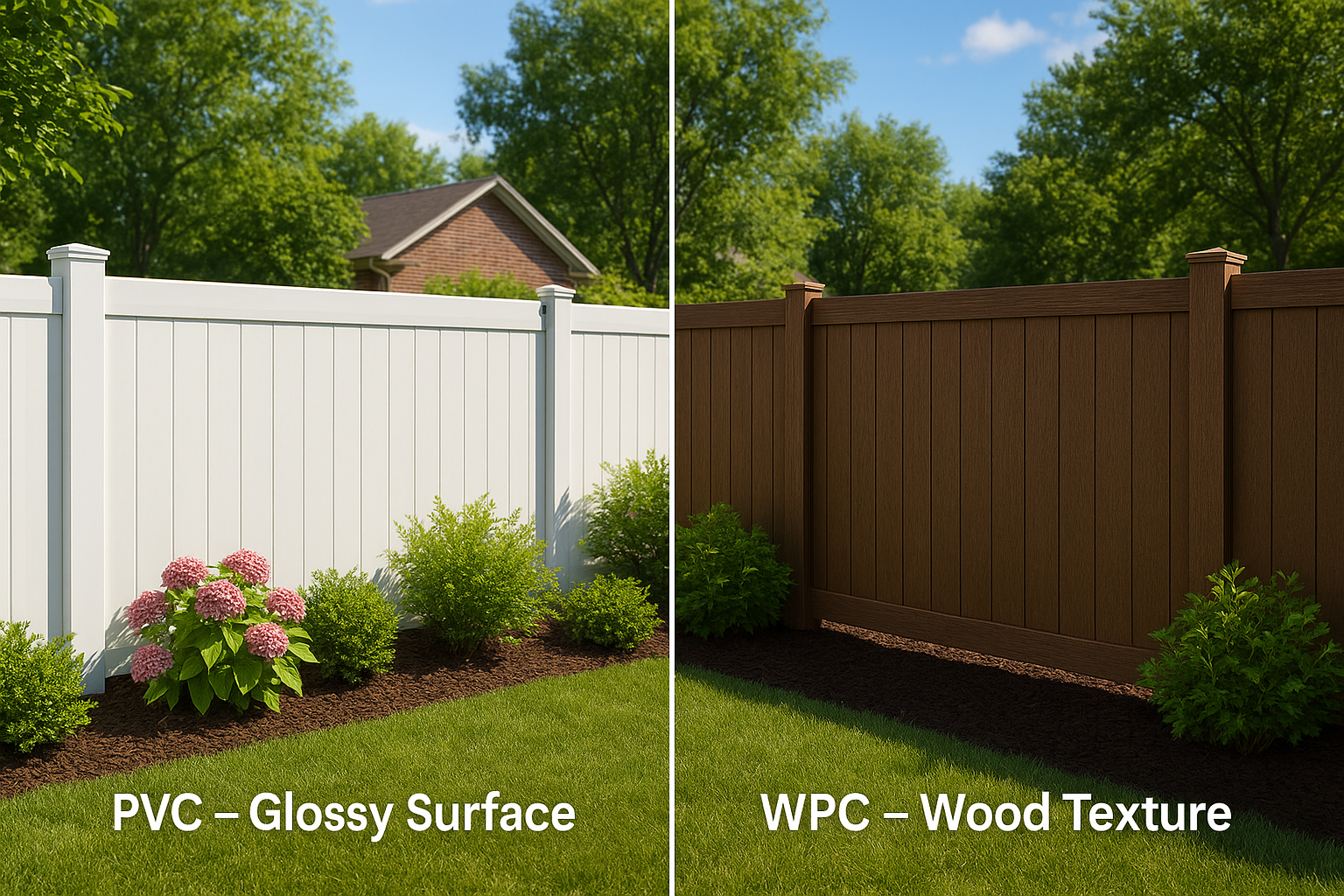
PVC vs WPC Fence – Which Is Better for Your Backyard in 2025?
The outdoor living trend continues to grow in 2025, and choosing the right fence has become an important decision for homeowners looking to enhance privacy, increase property value, and improve backyard aesthetics. Two materials are leading the fencing market today: PVC (vinyl) and WPC (Wood Plastic Composite). Both offer low maintenance and modern styling, but they differ significantly in durability, sustainability, appearance, and overall value.
This article takes an objective look at both materials while referencing Courtyardmart—a manufacturer specializing in outdoor fencing—as an industry example to help illustrate real-world applications.

🔎 What Are PVC and WPC Fences?
PVC Fence (Vinyl)
-
Made from synthetic plastic (polyvinyl chloride)
-
Lightweight and resistant to moisture
-
Often used in suburban and coastal regions
WPC Fence (Wood Plastic Composite)
-
A blend of recycled wood fibers and plastic
-
Offers the appearance of natural wood with improved engineering properties
-
Designed to balance sustainability and long-term performance
Manufacturers like Courtyardmart have adopted WPC to meet the growing demand for eco-friendly and durable fencing while offering modern designs that mimic real wood.
🧭 Comparison Overview for 2025
| Feature | PVC Fence | WPC Fence | Best For |
|---|---|---|---|
| Appearance | Smooth, artificial look | Wood-like texture & modern finishes | Homeowners who care about aesthetics |
| Durability | Can warp or crack under temperature changes | High resistance to impact, warping, and rot | Long-term property investment |
| Maintenance | Low maintenance | Low maintenance | Both |
| Weather Resistance | Strong against moisture but may yellow over time | Excellent in UV, moisture, and temperature extremes | Regions with harsh climates |
| Sustainability | Fully synthetic | Made from recycled materials | Eco-conscious households |
| Cost (initial) | Typically lower | Slightly higher | Short-term vs Long-term planning |
| Lifespan | 10–15 years | 20+ years | Long-term value seekers |
🎨 Appearance & Style
-
PVC has a clean, uniform appearance but can look glossy or artificial.
-
WPC offers realistic wood grain and is often chosen for modern or luxury landscaping projects.
Courtyardmart’s WPC fences are an example of how composite materials are being used to replicate high-end wood textures without requiring staining or repainting.
If aesthetics matter, WPC is generally preferred in 2025.
🔧 Durability & Structural Integrity
-
PVC fencing is strong against moisture but may become brittle in colder climates or warp under intense heat.
-
WPC fencing is engineered with a solid core (sometimes reinforced with aluminum), providing enhanced strength.
Real-world example:
Courtyardmart, as a direct manufacturer, reinforces its composite fences internally to improve structural stability—something not typically found in basic PVC models.
Verdict: WPC generally provides better long-term resilience.
☀️ Climate Performance in 2025
With extreme weather becoming more common, performance under environmental stress is critical:
| Weather Condition | PVC Performance | WPC Performance |
|---|---|---|
| UV Exposure | Can fade or yellow | UV stabilized, fade-resistant |
| Humidity | Waterproof | Waterproof + mold-resistant |
| Freezing Temps | May crack | Maintains structure |
WPC shows stronger performance in variable U.S. climates.
🌱 Environmental Considerations
-
PVC is petroleum-based and has a larger environmental footprint.
-
WPC is typically made from recycled materials, appealing to eco-conscious consumers.
Brands such as Courtyardmart have adopted recycled wood-plastic composites to reduce waste while providing long-lasting fencing options.
💵 Cost and Value
| Aspect | PVC | WPC |
|---|---|---|
| Initial Cost | More affordable | Slightly higher upfront |
| Maintenance | Minimal | Minimal |
| Replacement | May require after 10–15 years | 20+ year lifespan with warranties |
| Return on Investment | Moderate | Higher due to premium aesthetic |
If you plan to stay in your home long-term or want to increase resale value, WPC may offer better ROI. If you need a quick, cost-effective solution, PVC may be sufficient.
🏁 Final Conclusion: Which Is Better in 2025?
Both materials have advantages depending on your priorities:
Choose PVC if you:
-
Want a budget-friendly solution
-
Prefer a simple, low-maintenance fence
-
Live in a mild climate with minimal weather extremes
Choose WPC if you:
-
Want a natural wood-like appearance
-
Care about sustainability and long-term durability
-
Prefer a premium upgrade that can increase property value
📌 Courtyardmart is one example of a manufacturer focusing on WPC fencing due to rising demand for eco-friendly, low-maintenance, and custom-designed outdoor products. Their direct-to-consumer model provides factory-level customization and a warranty-backed fence option for long-term homeowners.
🗨 Your Decision in 2025
Whether you choose PVC or WPC depends on your lifestyle, budget, and long-term plans for your property. If design and durability are your top priorities, WPC has a clear advantage in 2025. If cost and simplicity matter most, PVC remains a practical option.
Which one fits your backyard vision?
Are you looking for a short-term solution or a long-term investment that enhances the value of your home?
Share your thoughts in the comments below.
Backyard Design, Home Improvement, Outdoor Living, Sustainable Living, PVC Fence, WPC Fence, Homeowners



Leave a comment
This site is protected by hCaptcha and the hCaptcha Privacy Policy and Terms of Service apply.